
The Colorado Governor's Mansion, also known as the Cheesman-Boettcher Mansion, is a historic U.S. mansion in Denver, Colorado. It is located at 400 East 8th Avenue. On December 3, 1969, it was added to the U.S. National Register of Historic Places. It is open free-of-charge for scheduled tours, and also hosts special public events.

The Pierre Masonic Lodge is a building in Pierre, South Dakota that was designed by architects Perkins & McWayne in Classical Revival style. The building was built in 1928 to house Pierre Lodge 27 A.F. and A.M., which formed in 1881. The building's design features a pediment at the top of the building, Ionic columns flanking the entrance, and ornamentation below the eaves. The lodge was listed on the U.S. National Register of Historic Places in 2009.
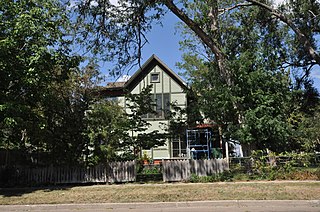
The Dr. William and Elizabeth Blackburn House is a historic two-story wooden house located in Pierre, South Dakota. Designed in the Stick or Eastlake style of Queen Anne style architecture, it was built in 1883 by local banker and real estate speculator, H. O. Fishback. In 1887, it was bought by the Rev. Dr. William Maxwell Blackburn and his wife, Elizabeth Powell Blackburn, who had come to Pierre from Grand Forks, North Dakota, where he had been president of the University of North Dakota. Dr. Blackburn, a Presbyterian minister, scholar and author became the founding president of the Presbyterian University of Southern Dakota, which later became Pierre University and served as such until his death in 1898. Following his death, Pierre University was relocated to Huron, where it became Huron University. Later owners include C. B. Billinghurst, local newspaper publisher, and Harold King and his wife Irma E. King. The Kings ran a grocery store and he was a local politician while she was a poet.

The Former North Dakota Executive Mansion, also or formerly known as Old Governor's Mansion or Asa Fisher House, at 320 Ave. B., E., in Bismarck, North Dakota, was built in 1893.
Wallace L. Dow, often known as W.L. Dow, was an architect of Sioux Falls, South Dakota.

The Reid House is a historic house located at 2013 S. Prairie Avenue in the Near South Side community area of Chicago, Illinois. Built in 1894, the house was designed by the firm Beers, Clay and Dutton in the Classical Revival style. The house's design features a narrow entry portico with Ionic columns and terra cotta decorations, a fanlight and sidelights on the front door, a cornice with a modillion, and Adamesque ornaments. In addition, the house was the first residence built with a steel frame. Chicago businessman William Henry Reid owned the house, which he built to replace his previous home at the same location.
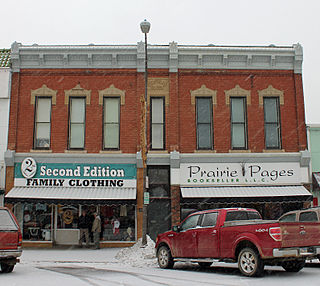
The Central Block is a historic commercial building located at 321–325 S. Pierre St. in Pierre, South Dakota. The Commercial style masonry building was constructed in 1884 and was one of Pierre's earliest masonry commercial buildings. The building opened by hosting the 1884 Republican Territorial Convention Ball, which featured a performance by the Rochester Orchestra. Since its opening, the building has housed numerous businesses and offices, including those of Alice Baird, Pierre's first female doctor, and Henry R. Horner, South Dakota State Senator and Pierre City Attorney. The building is now one of the only surviving buildings from Pierre's first commercial district.

The Brink–Wegner House is a historic house located at 110 E. 4th St. in Pierre, South Dakota. The house was built in 1904 for Andrew C. Brink, a real estate contractor. The house's Shingle style design features a gambrel roof and a bay window with a cone-shaped roof on the second floor. Four different shingle designs are used to side the house above the first floor. The house's dining room features a mural on the ceiling, part of an interior the National Park Service called "one of the best period interiors in the State". In 1923, Henry C. Wegner, who owned the state's first automobile agency, bought the home. The house was moved from 109 South Highland Avenue to its current location in 1977.

The St. Charles Hotel is a historic hotel located at 207 E. Capitol Ave. in Pierre, South Dakota. The hotel was built in 1911 by Charles Hyde, a prominent Pierre businessman. Hyde had helped establish Pierre's business district; he was later convicted of mail fraud and pardoned by President William Howard Taft. South Dakota Governor Robert S. Vessey hosted the hotel's grand opening, a portent of the hotel's role in South Dakota politics. All members of both houses of the South Dakota Legislature stayed in the hotel while in Pierre, and the legislators often discussed and debated bills in the building. In addition, several governors stayed in the hotel until the South Dakota governor's mansion was built in the 1940s. The hotel has also hosted prominent guests such as President Calvin Coolidge, Dale Carnegie, Bob Hope, and Clark Gable.
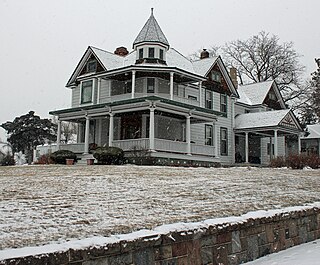
The Crawford–Pettyjohn House is a historic house located at 129 S. Washington St. in Pierre, South Dakota. The Queen Anne style house was built in 1885. The house's design features a porch that wraps around the south and east sides, a hipped roof with cross gables, and a corner turret. Coe I. Crawford, who later became governor of South Dakota, was the house's first owner; Crawford lived in the house until 1896. Governor Robert S. Vessey may have also lived in the house during his time in office. In 1919, Frank Pettyjohn, who owned multiple local grain elevators, bought the house.
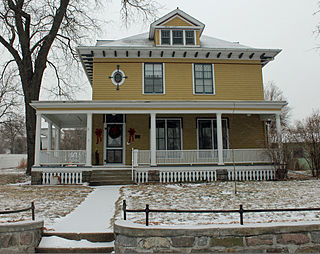
The I. W. Goodner House is a historic house located at 216 E. Prospect Avenue in Pierre, South Dakota. The house, one of the oldest in Pierre, was built between 1881 and 1885 for I. W. Goodner, the first clerk of the South Dakota Supreme Court. While the house was built with a Gothic Revival design, Goodner remodeled the house in the 1900s, converting it to a Colonial Revival home. The renovated house featured a new second story and attic and a wraparound porch supported by Tuscan columns.

The John E. and Ruth Hipple House is a historic house located at 219 N. Highland in Pierre, South Dakota. Built in 1913, the Prairie School house features a roof with a low pitch and overhanging eaves, a front porch, and a horizontal emphasis throughout its design. The home was originally owned by John E. and Ruth Hipple, both of whom were prominent Pierre citizens. John served as Pierre's mayor from 1924 to 1939 and owned the Capital Journal, while Ruth was an important figure in the local women's suffrage movement.

The Karcher–Sahr House is a historic house located at 222 E. Prospect St. in Pierre, South Dakota. Built in 1910, the house was designed in the Classical Revival style. The house's design features a dentillated cornice with modillions and moldings, two-story Ionic columns supporting a pediment over the front entrance, and a front and side porch. The house's first owner, Henry Karcher, was an early settler and businessman in Pierre who also served as the city's mayor. After his daughter Marguerite married Fred Sahr, the couple lived in the house. Marguerite was a prominent activist for women's suffrage, and her son William was a state legislator.
The Augustus and Augusta Gerhart House is a historic house at 321 Iowa Street in Highmore, South Dakota. It is a two-story wood-frame structure, built in 1889 by Christina Grant. It was purchased in 1896 by Augustus "Gus" and Augusta Gerhart, who lived there until her death (1906) and his move to Pierre after remarrying (1919). Gus Gerhart was a leading citizen of Highmore and South Dakota, arriving in 1882, and starting its first business, a lumber yard, soon thereafter. The house originally featured a Folk Victorian front gable, and was enlarged by the Gerharts soon after their purchase to make a cross gable plan. The house was damaged by lightning in 1928, resulting in some alterations, including the construction of an enclosed porch on the east facade.
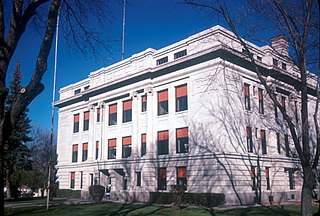
The Hamlin County Courthouse, located at 300 4th Street in Hayti, is the county courthouse serving Hamlin County, South Dakota. The courthouse was completed in 1916, two years after the Hamlin county seat was moved to Hayti from Castlewood by popular vote. Architects William W. Rose and David B. Peterson of Kansas City, Missouri designed the courthouse; their Classical Revival design was typical of contemporary courthouse architecture in South Dakota. The four-story limestone building features four Ionic columns along the front facade and an entablature with an egg-and-dart frieze and a dentillated cornice. The building has served as the seat of county government since its opening.

The Mellette House is a historic home and museum located at 421 Fifth Avenue Northwest in Watertown, South Dakota. It is the former residence of the first governor of South Dakota, Arthur C. Mellette.

The Butte County Courthouse and Historic Jail Building is a historic site in Belle Fourche, South Dakota. The buildings were placed on the National Register of Historic Places in 1998, with its significance being its association with the growth of local government in western plains communities, local figure Seth Bullock, and for making use of Classical architecture, representative of contemporary South Dakota public buildings.
The Marcus Beebe House, in Ipswich, South Dakota, is a historic house built in 1910. It was listed on the National Register of Historic Places in 1976.

Mary Ella Noyes Farr was an American osteopathic physician, educator, clubwoman, and suffragist, based in Pierre, South Dakota.

Inman House, formerly known as the University of South Dakota Alumni House, is a historic American building in Vermillion, South Dakota. It is currently a private residence for the President of the University of South Dakota. It was added to the National Register of Historic Places in 1976.



















